Effect of Climate and Competition on Radial Growth of Pinus sylvestris var. mongolica Forest in Hulunbuir Sandy Land of Inner Mongolia, China
Abstract
1. Introduction
2. Results
2.1. Characteristics of Tree-Ring Chronology
2.2. Radial Growth–Climate Correlation
2.3. Tree-to-Tree Competitions and Their Effect on Cumulative Basal Area Increment (BAI)
2.4. Comprehensive Effect of Competition and Climate on Tree Growth
3. Discussion
3.1. Effect of Climate on Tree Growth
3.2. Effect of Competition on Tree Growth
3.3. Comprehensive Effects of Climate and Competition on Tree Growth
4. Materials and Methods
4.1. Study Area
4.2. Climatic Data
4.3. Field Investigation and Establishment of Tree-Ring Chronology
4.4. Competition Index (CI)
4.5. Statistical Analysis
5. Conclusions
Author Contributions
Funding
Data Availability Statement
Acknowledgments
Conflicts of Interest
References
- Lu, W.; Yu, X.; Jia, G.; Li, H.; Liu, Z. Responses of Intrinsic Water-use Efficiency and Tree Growth to Climate Change in Semi-Arid Areas of North China. Sci. Rep. 2018, 8, 308. [Google Scholar]
- Huang, X.; Dai, D.; Xiang, Y.; Yan, Z.; Xiao, W. Radial growth of Pinus massoniana is influenced by temperature, precipitation, and site conditions on the regional scale: A meta-analysis based on tree-ring width index. Ecol. Indic. 2021, 126, 107659. [Google Scholar] [CrossRef]
- Yasmeen, S.; Wang, X.; Zhao, H.; Zhu, L.; Han, S. Contrasting climate-growth relationship between Larix gmelinii and Pinus sylvestris var. mongolica along a latitudinal gradient in daxing’an mountains, China. Dendrochronologia 2019, 58, 125645. [Google Scholar]
- Jiao, L.; Xue, R.; Qi, C.; Chen, K.; Liu, X. Comparison of the responses of radial growth to climate change for two dominant coniferous tree species in the eastern Qilian Mountains, northwestern China. Int. J. Biometeorol. 2021, 65, 1823–1836. [Google Scholar] [CrossRef]
- Wu, Q.; Zhang, X.; Xu, S.; Yang, X.; Liu, Y.; Li, H.; Shi, Z. Climatic responses of NDVI and tree growth in the arid areas of inland Asia and their influencing factors. J. Desert Res. 2022, 42, 1–10. (In Chinese) [Google Scholar]
- Shi, Z.; Xu, L.; Dong, L.; Gao, J.; Yang, X.; Lu, S.; Feng, C.; Shang, J.; Song, A.; Guo, H. Growth-climate response and drought reconstruction from tree-ring of Mongolian pine in Hulunbuir, Northeast China. J. Plant Ecol. 2016, 9, 51–60. [Google Scholar] [CrossRef]
- Gazol, A.; Camarero, J.J.; Vicente-Serrano, S.M.; Sánchez-Salguero, R.; Gutiérrez, E.; de Luis, M.; Sangüesa-Barreda, G.; Novak, K.; Rozas, V.; Tíscar, P.; et al. Forest resilience to drought varies across biomes. Glob. Chang. Biol. 2018, 24, 2143–2158. [Google Scholar] [CrossRef] [PubMed]
- Serra-Maluquer, X.; Mencuccini, M.; Martínez-Vilalta, J. Changes in tree resistance, recovery and resilience across three successive extreme droughts in the northeast Iberian Peninsula. Oecologia 2018, 187, 343–354. [Google Scholar] [CrossRef]
- Mausolf, K.; Wilm, P.; Härdtle, W.; Jansen, K.; Schuldt, B.; Sturm, K.; von Oheimb, G.; Hertel, D.; Leuschner, C.; Fichtner, A. Higher drought sensitivity of radial growth of European beech in managed than in unmanaged forests. Sci. Total Environ. 2018, 642, 1201–1208. [Google Scholar] [CrossRef]
- Phillip, J.; Lucy, P.; Rosemary, L.; Zachary, J.; Zachary, J. Tree-Ring Evidence of Forest Management Moderating Drought Responses: Implications for Dry, Coniferous Forests in the Southwestern United States. Front. For. Glob. Chang. 2020, 3, 41. [Google Scholar]
- Alessandra, B.; Anthony, W.; Brian, J.; John, B.; Shawn, F.; Mike, A.; Lance, A. Density-dependent vulnerability of forest ecosystems to drought. J. Appl. Ecol. 2017, 54, 1605–1614. [Google Scholar]
- D’Amato, A.; Bradford, J.; Fraver, S.; Palik, B. Effects of thinning on drought vulnerability and climate response in north temperate forest ecosystems. Ecol. Appl. 2013, 23, 1735–1742. [Google Scholar] [CrossRef]
- Lu, K.; Chen, N.; Zhang, C.; Dong, X.; Zhao, C. Drought Enhances the Role of Competition in Mediating the Relationship between Tree Growth and Climate in Semi-Arid Areas of Northwest China. Forests 2019, 10, 804. [Google Scholar] [CrossRef]
- Navarro-Cerrillo, R.; Manzanedo, R.; Rodriguez-Vallejo, C.; Gazol, A.; Palacios-Rodríguez, G.; Camarero, J. Competition modulates the response of growth to climate in pure and mixed Abies pinsapo subsp. Maroccana forests in northern Morocco. For. Ecol. Manag. 2020, 459, 117847. [Google Scholar]
- Latreille, A.; Davi, H.; Huard, F.; Pichot, C. Variability of the climate-radial growth relationship among Abies alba trees and populations along altitudinal gradients. For. Ecol. Manag. 2017, 396, 150–159. [Google Scholar] [CrossRef]
- Kwon, S.; Pang, L.; Khan, A.; Zhang, K. The effect of density gradient on spatial distribution and growth dynamics of natural Pinus sylvestris L. var. Mongolica litv. pure forest in northeast China. Fresenius Environ. Bull. 2019, 28, 3963–3980. [Google Scholar]
- Fernández-de-Uña, L.; McDowell, N.G.; Cañellas, I.; Gea-Izquierdo, G. Disentangling the effect of competition, CO2 and climate on intrinsic water-use efficiency and tree growth. J. Ecol. 2016, 104, 678–690. [Google Scholar] [CrossRef]
- Buechling, A.; Martin, P.; Canham, C.; Piper, F. Climate and competition effects on tree growth in Rocky Mountain forests. J. Ecol. 2017, 105, 1636–1647. [Google Scholar] [CrossRef]
- Alam, S.; Huang, J.; Stadt, K.; Comeau, P.; Dawson, A.; Gea-Izquierdo, G.; Aakala, T.; Holtta, T.; Vesala, T.; Makela, A. Effects of Competition, Drought Stress and Photosynthetic Productivity on the Radial Growth of White Spruce in Western Canada. Front. Plant Sci. 2017, 8, 1915. [Google Scholar] [CrossRef]
- Putnam, R.; Reich, P. Climate and competition affect growth and survival of transplanted sugar maple seedlings along a 1700-km gradient. Ecol. Monogr. 2017, 87, 130–157. [Google Scholar] [CrossRef]
- Felix, O.; Philip, G. The interactive effect of competition and climate on growth of boreal tree species in western Canada and Alaska. Can. J. For. Res. 2020, 50, 457–464. [Google Scholar]
- Wigley, T.; Briffa, K.; Jones, P. On the average value of correlated time series, with applications in dendroclimatology and hydrometeorology. J. Clim. Appl. Meteorol. 1984, 23, 201–213. [Google Scholar] [CrossRef]
- Zhang, X.; Wu, M.; Kwon, S.; Pan, L.; Han, H.; Yang, X.; Liu, Y.; Shi, Z. Radial growth responses of Mongolian pine (Pinus sylvestris var. mongolica) plantations at different ages to climate and groundwater level changes. Acta Ecol. Sin. 2022, 42, 6827–6837. (In Chinese) [Google Scholar]
- Zhang, X.; Pan, L.; Kwon, S.; Liu, Y.; Yang, X.; Shi, Z. Climatological response of radial growth for Pinus sylvestris var. mongolica to drought in Hulun Buir Sandland, Inner Mongolia of northern China. J. Beijing For. Univ. 2018, 40, 27–35. (In Chinese) [Google Scholar]
- Shang, J.; Shi, Z.; Gao, J.; Xu, L.; LÜ, S.; Feng, C.; Wang, L. Response of tree-ring width of Pinus sylvestris var. mongolica to climate change in Hulunbuir sand land, China. Acta Ecol. Sin. 2012, 32, 1077–1084. (In Chinese) [Google Scholar] [CrossRef]
- Wang, X.; Song, L.; Zhang, Y. Climate-tree growth relationships of Pinus sylvestris var. mongolica in the northern Daxing’an Mountains, China. Chin. J. Plant Ecol. 2011, 35, 294–302. (In Chinese) [Google Scholar] [CrossRef]
- Liang, R.; Shao, X.; Liu, H.; Eckstein, D. Changes of PDSI recorded by tree rings in Hunshandake sandy land in eastern Inner Mongolia since 1842. Chin. Sci. Bull. 2007, 52, 1694–1699. (In Chinese) [Google Scholar] [CrossRef]
- Kang, J.; Liang, H.; Jiang, S.; Zhu, H.; Zhou, P.; Huang, J. Effects of competition and climate on tree radial growth of Pinus sibirica in Altai Mountains, Xinjiang, China. Chin. J. Plant Ecol. 2020, 44, 1195–1202. (In Chinese) [Google Scholar] [CrossRef]
- Liang, H.; Huang, J.; Ma, Q.; Li, J.; Wang, Z.; Guo, X.; Zhu, H.; Jiang, S.; Zhou, P.; Yu, B.; et al. Contributions of competition and climate on radial growth of Pinus massoniana in subtropics of China. Agric. For. Meteorol. 2019, 274, 7–17. [Google Scholar] [CrossRef]
- Han, D.; Jin, G. Influences of topography and competition on DBH growth in different growth stages in a typical mixed broadleaved-Korean pine forest, northeastern China. J. Beijing For. Univ. 2017, 39, 9–19. (In Chinese) [Google Scholar]
- Wang, Z.; Yang, H.; Wang, D.; Zhao, Z. Response of height growth of regenerating trees in a Pinus tabulaeformis Carr. plantation to different thinning intensities. For. Ecol. Manag. 2019, 444, 280–289. [Google Scholar] [CrossRef]
- Zhang, J.; Kaelyn, A.; David, H.; Gary, O.; Christopher, L. Growth Response of Ponderosa Pine to Intensive Cultural Treatments Varies with Site Quality and Plantation Age. For. Sci. 2022, 68, 212–225. [Google Scholar] [CrossRef]
- Dušek, D.; Novak, J.; Kacálek, D.; Slodičák, M. Norway spruce production and static stability in IUFRO thinning experiments in the Czech Republic. J. For. Sci. 2021, 67, 185–194. [Google Scholar] [CrossRef]
- Sohn, J.; Saha, S.; Bauhus, J. Potential of forest thinning to mitigate drought stress: A meta-analysis. For. Ecol. Manag. 2016, 380, 261–273. [Google Scholar] [CrossRef]
- Kang, Y.; Liu, B.; Ren, J.; Tan, K. Effect of Competitionon Tree Ring Growth and Climate Factors of Pinus koraiensis. J. Northeast For. Univ. 2019, 47, 6–10. (In Chinese) [Google Scholar]
- Nicklen, E.; Roland, C.; Csank, A.; Wilmking, M.; Ruess, R.; Muldoon, L. Stand basal area and solar radiation amplify white spruce climate sensitivity in interior Alaska: Evidence from carbon isotopes and tree rings. Glob. Chang. Biol. 2019, 25, 911–926. [Google Scholar] [CrossRef]
- Fernandez-Tschieder, E.; Binkley, D. Linking competition with Growth Dominance and production ecology. For. Ecol. Manag. 2018, 414, 99–107. [Google Scholar] [CrossRef]
- Zhang, J.; Huang, S.; He, F. Half-century evidence from western Canada shows forest dynamics are primarily driven by competition followed by climate. Proc. Natl. Acad. Sci. USA 2015, 112, 4009–4014. [Google Scholar] [CrossRef] [PubMed]
- Holmes, R. Computer-assisted quality control in tree-ring dating and measurement. Tree-Ring Bull. 1983, 43, 69–78. [Google Scholar]
- Bunn, A. A dendrochronology program library in R (dplR). Dendrochronologia 2008, 26, 115–124. [Google Scholar] [CrossRef]
- Cook, E. A Time Series Analysis Approach to Tree Ring Standardization. Ph.D. Thesis, University of Arizona, Tucson, Arizona, 1985. [Google Scholar]
- Biondi, F.; Qeadan, F. A theory-driven approach to tree-ring standardization: Defining the biological trend from expected basal area increment. Tree-Ring Res. 2008, 64, 81–96. [Google Scholar] [CrossRef]
- Carnwath, G.; Nelson, C. The effect of competition on responses to drought and interannual climate variability of a dominant conifer tree of western North America. J. Ecol. 2016, 104, 1421–1431. [Google Scholar] [CrossRef]
- Elieser, V.; Djoko, M.; Ronggo, S.; Muhammad, A. Ideal planting space for merbau (Intsia bijuga) forest plantations in papua based on distance-dependent competition. Biodiversitas 2018, 19, 2219–2231. [Google Scholar]
- Maertens, S. A metric to assess the competitive position of airlines and airline groups in the intra-European air transport market. Res. Transp. Econ. 2018, 72, 65–73. [Google Scholar] [CrossRef]
- Fukumoto, K.; Nishizono, T.; Kitahara, F. Individual-level distance-independent-based growth and yield prediction models for long-term Japanese cedar (Cryptomeria japonica). Can. J. For. Res. 2022, 52, 439–652. [Google Scholar] [CrossRef]
- Keiko, F.; Tomohiro, N.; Fumiaki, K.; Kazuo, H. Evaluation of Individual Distance-Independent Diameter Growth Models for Japanese Cedar (Cryptomeria japonica) Trees under Multiple Thinning Treatments. Forests 2020, 11, 344. [Google Scholar]
- Hegyi, F. A Simulation Model for Managing Jack-Pine Stands. Growth Models for Tree and Stand Simulation; Fries, J., Ed.; Royal College of Forestry: Stockholm, Sweden, 1974; pp. 74–90. [Google Scholar]
- Pan, L.; Kwon, S.; Liu, Y.; Zhang, X.; Yang, X.; Shan, D.; Zhu, Y.; Shi, Z. Tree competition, spatial pattern, and regeneration of a Mongolian pine natural forest in the southern geographical edge. Acta Ecol. Sin. 2019, 39, 3687–3699. (In Chinese) [Google Scholar]
- Barton, K. MuMIn: Multi-Model Inference, R Package Version 1.47.1 [31 August 2022]. Available online: http://cran.r-project.org/web/packages/MuMIn (accessed on 12 December 2022).
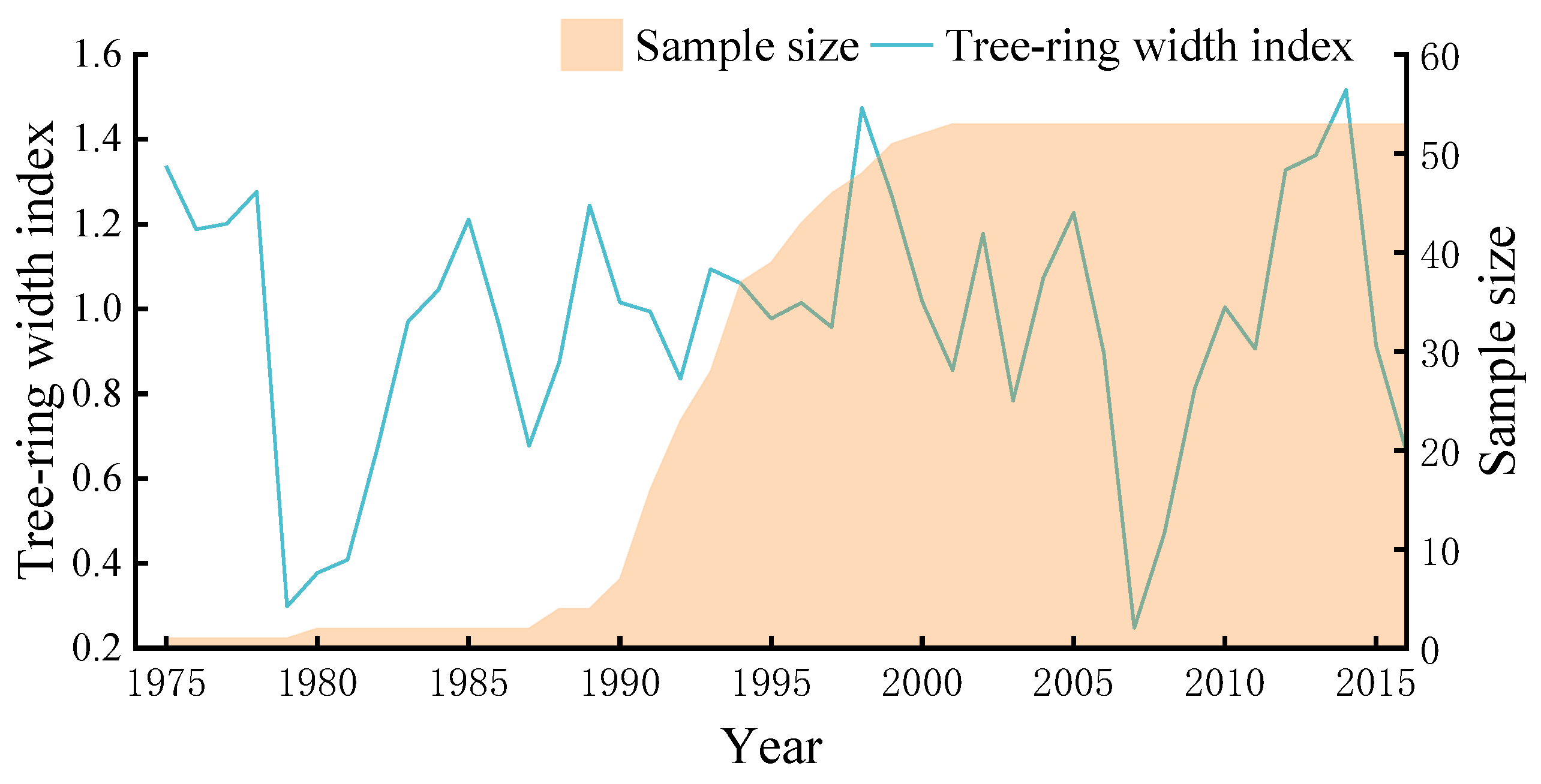
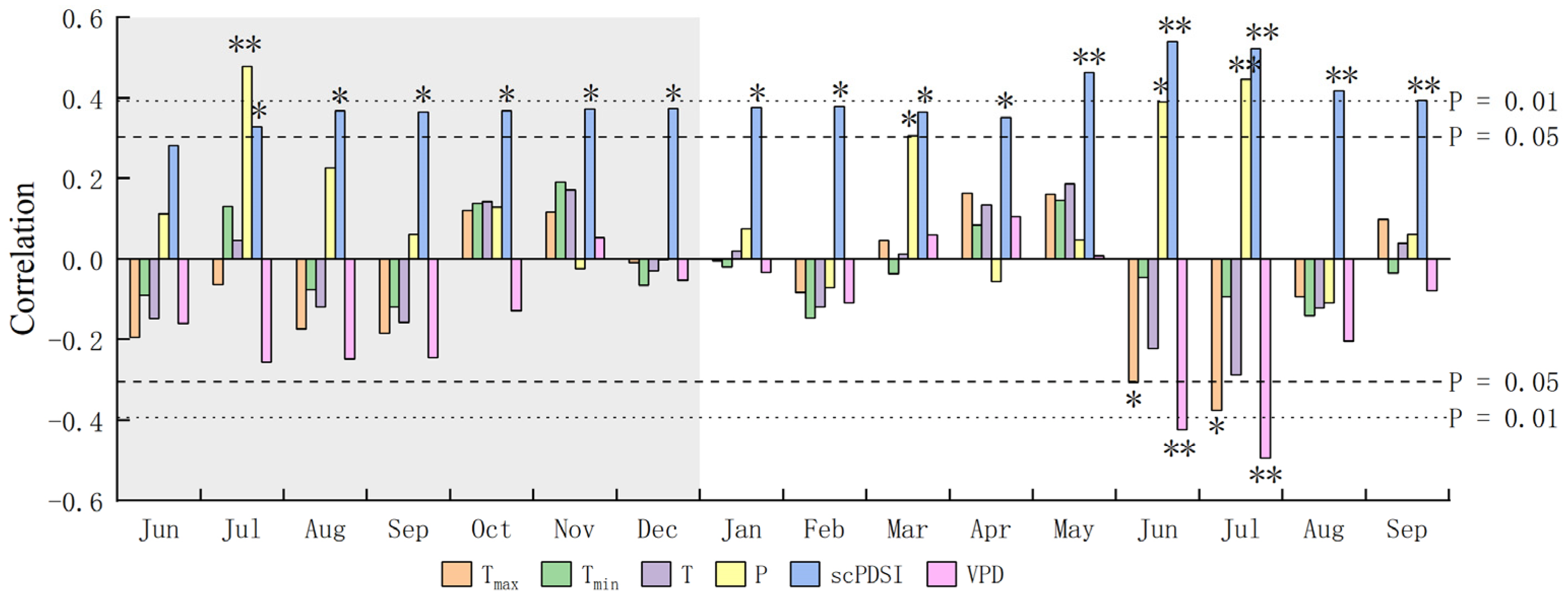
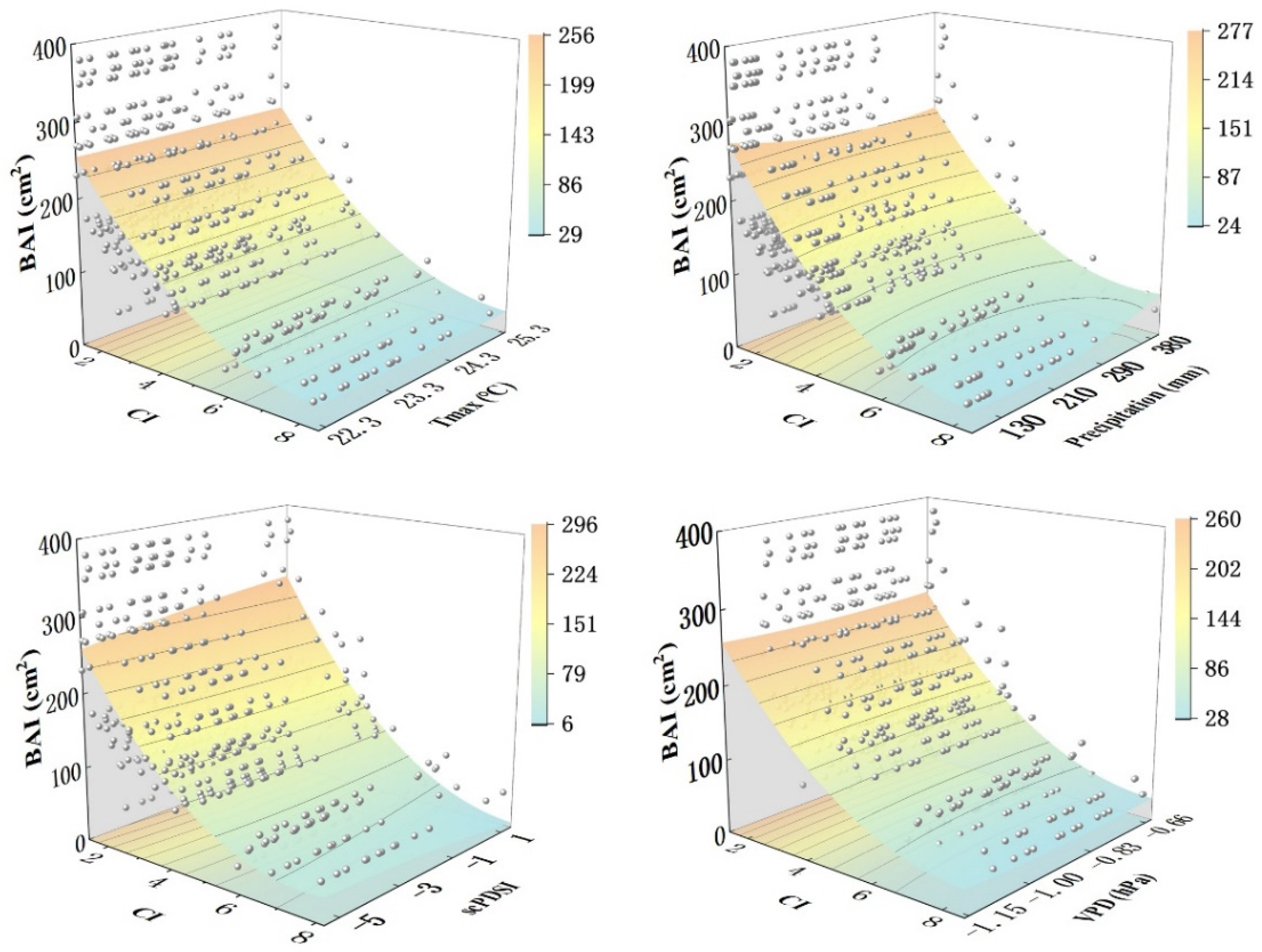
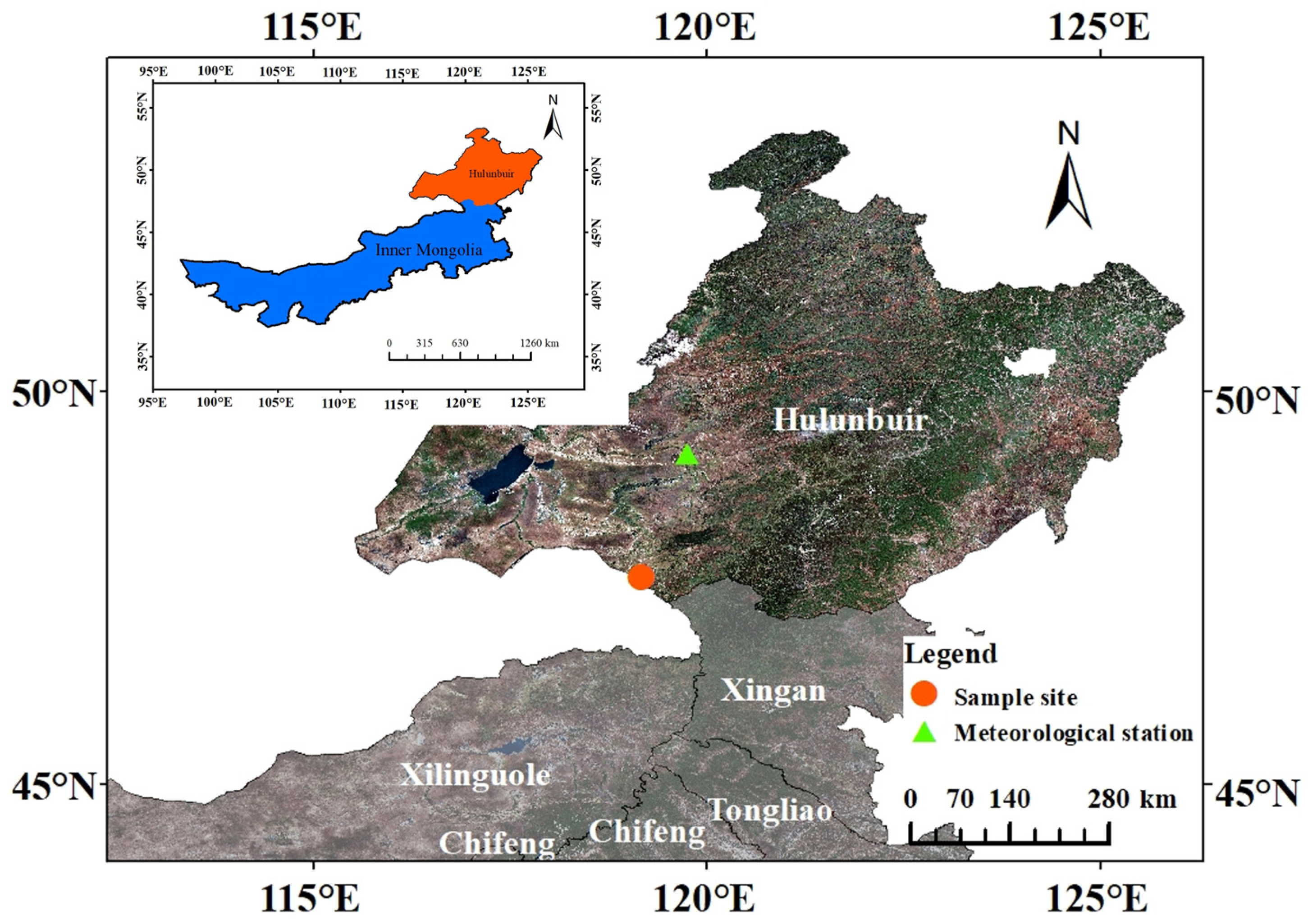
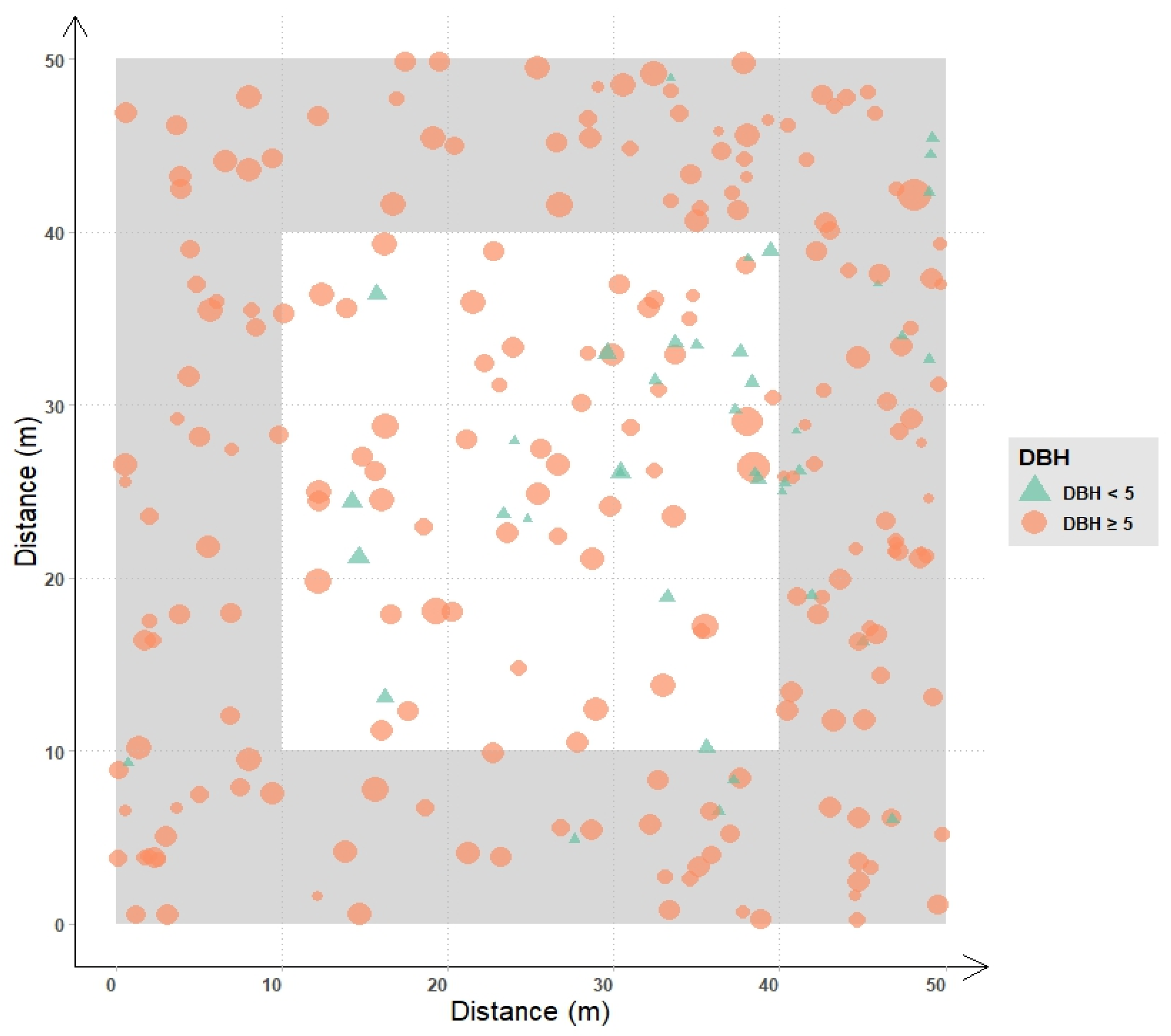
| Period | Trees/Cores | MS | SD | CC | SNR | EPS | AC |
|---|---|---|---|---|---|---|---|
| 1975–2016 | 53/106 | 0.347 | 0.391 | 0.790 | 201.715 | 0.995 | 0.598 |
| Cumulated Time Interval (Year) | a | b | Marginal R2 |
|---|---|---|---|
| 5 | 165.35 | 0.990 | 0.7446 |
| 10 | 265.41 | 1.005 | 0.7602 |
| 15 | 434.52 | 1.056 | 0.7633 |
| Predictor Variable | Estimated Value | Range | p | |
|---|---|---|---|---|
| Fixed effect | Inception | 1805.67 | 1545.71–2065.63 | <0.001 |
| Tree age | 32.73 | 29.07–36.39 | <0.001 | |
| CI | −197.22 | −238.56–−155.87 | <0.001 | |
| May–July scPDSI | 110.95 | 84.01–137.89 | <0.001 | |
| May–July VPD | −725.95 | −982.46–−469.44 | <0.001 | |
| CI × May–July scPDSI | −16.57 | −22.56–−10.57 | <0.001 | |
| Random effects | σ2 | 217,954.60 | ||
| τ00 TreeID | 96,515.89 | |||
| ICC | 0.31 | |||
| NTreeID | 53 | |||
| sample size | 1267 | |||
| Marginal R2/Conditional R2 | 0.425/0.601 |
Disclaimer/Publisher’s Note: The statements, opinions and data contained in all publications are solely those of the individual author(s) and contributor(s) and not of MDPI and/or the editor(s). MDPI and/or the editor(s) disclaim responsibility for any injury to people or property resulting from any ideas, methods, instructions or products referred to in the content. |
© 2023 by the authors. Licensee MDPI, Basel, Switzerland. This article is an open access article distributed under the terms and conditions of the Creative Commons Attribution (CC BY) license (https://creativecommons.org/licenses/by/4.0/).
Share and Cite
Wen, S.; Shi, Z.; Zhang, X.; Pan, L.; Kwon, S.; Li, Y.; Yang, X.; Li, H. Effect of Climate and Competition on Radial Growth of Pinus sylvestris var. mongolica Forest in Hulunbuir Sandy Land of Inner Mongolia, China. Plants 2023, 12, 2584. https://doi.org/10.3390/plants12132584
Wen S, Shi Z, Zhang X, Pan L, Kwon S, Li Y, Yang X, Li H. Effect of Climate and Competition on Radial Growth of Pinus sylvestris var. mongolica Forest in Hulunbuir Sandy Land of Inner Mongolia, China. Plants. 2023; 12(13):2584. https://doi.org/10.3390/plants12132584
Chicago/Turabian StyleWen, Shuo, Zhongjie Shi, Xiao Zhang, Leilei Pan, Semyung Kwon, Yuheng Li, Xiaohui Yang, and Hanzhi Li. 2023. "Effect of Climate and Competition on Radial Growth of Pinus sylvestris var. mongolica Forest in Hulunbuir Sandy Land of Inner Mongolia, China" Plants 12, no. 13: 2584. https://doi.org/10.3390/plants12132584
APA StyleWen, S., Shi, Z., Zhang, X., Pan, L., Kwon, S., Li, Y., Yang, X., & Li, H. (2023). Effect of Climate and Competition on Radial Growth of Pinus sylvestris var. mongolica Forest in Hulunbuir Sandy Land of Inner Mongolia, China. Plants, 12(13), 2584. https://doi.org/10.3390/plants12132584






